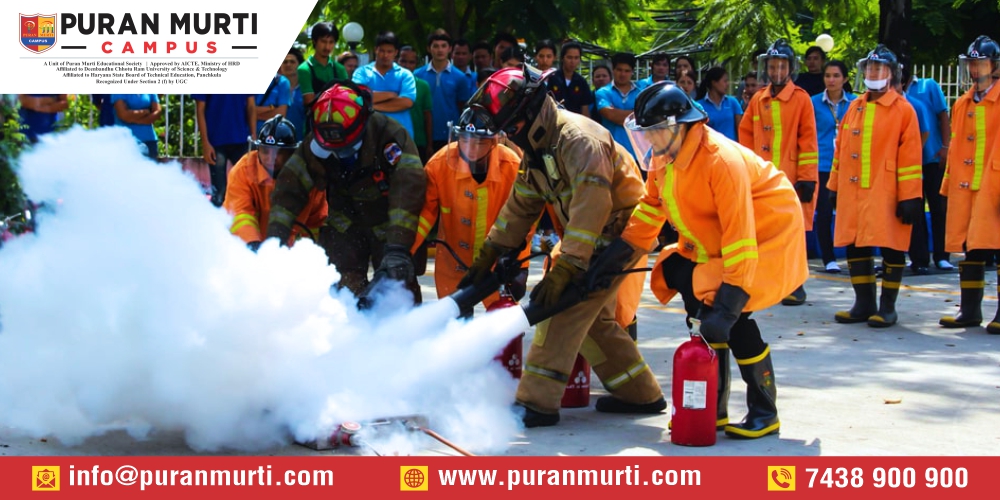Protecting Lives: The Essential Role of a Diploma in Fire Technology and Safety
Posted on : 21 June, 2024 4:45 pm
Introduction
- Fire technology and safety is a critical field dedicated to protecting lives and property from the dangers of fire. This discipline encompasses the study of fire prevention, control, and mitigation techniques, as well as the implementation of safety regulations and standards. Through a comprehensive curriculum and hands-on training, students in a diploma program in fire technology and safety learn essential skills such as emergency response, risk assessment, and fire prevention strategies. Graduates are well-equipped to pursue careers in various sectors, ensuring the safety and well-being of communities and industries.
Core Curriculum
- The core curriculum of a Diploma in Fire Technology and Safety includes subjects such as fire science, fire prevention, safety regulations, emergency response, risk assessment, and hazardous materials management. Students also engage in practical training through drills and simulations, gaining hands-on experience in firefighting techniques, equipment handling, and safety protocol implementation.
Hands-On Training
- Hands-on training in a Diploma in Fire Technology and Safety bridges theory and practice by providing real-world experience. Students participate in simulations, firefighting drills, and emergency response exercises. This practical training helps them master the use of firefighting equipment, understand safety protocols, and develop critical skills needed to effectively manage fire incidents and ensure public safety.
Safety Regulations and Standards
- Safety regulations and standards in fire technology ensure effective prevention, management, and response to fire incidents. These guidelines include building codes, fire safety protocols, and emergency response procedures. Students learn about national and international standards, such as NFPA codes, to ensure compliance and enhance safety measures, preparing them to implement and enforce these regulations in real-world scenarios.
Emergency Response Techniques
- Emergency response techniques in fire technology focus on swift, effective action during fire incidents. Training covers fire suppression, evacuation procedures, and first aid. Students learn to use firefighting equipment, conduct rescues, and manage emergency situations. Mastery of these techniques ensures quick, coordinated responses to minimize damage, save lives, and maintain safety during emergencies.
Fire Prevention and Risk Assessment
- Fire prevention and risk assessment are crucial components of fire safety. Training includes identifying potential fire hazards, implementing safety measures, and conducting regular inspections. Students learn to assess risks, develop fire prevention strategies, and ensure compliance with safety regulations. This proactive approach minimizes fire risks, enhances safety, and protects lives and property from potential fire incidents.
Field Experience and Internships
- Field experience and internships are integral to a diploma in Fire Technology and Safety. These opportunities provide hands-on learning in real-world settings, allowing students to apply classroom knowledge to practical situations. Internships with fire departments, safety agencies, and industrial sites offer invaluable experience, enhancing skills in emergency response, fire prevention, and risk assessment.
Career Opportunities in Fire Safety
- A diploma in Fire Technology and Safety opens up diverse career opportunities. Graduates can work as fire safety officers, fire inspectors, risk assessors, and emergency response coordinators. They are also in demand in industries such as manufacturing, construction, and public safety. With advanced training, they can pursue roles in fire investigation, safety consultancy, and training.
Challenges in the Field
- In the field of fire technology and safety, professionals face various challenges. These include ensuring compliance with evolving safety regulations, managing high-risk situations effectively, and keeping pace with technological advancements in fire prevention and mitigation. Additionally, maintaining public awareness and education about fire safety measures is crucial. Overcoming these challenges requires continuous training, adaptation to new techniques, and collaboration with other emergency response agencies.
Conclusion
- In conclusion, a diploma in fire technology and safety equips individuals with essential skills to protect lives and property from fire hazards. Through rigorous training in safety regulations, emergency response techniques, and risk assessment, graduates are prepared to handle diverse challenges in the field. The diploma program not only focuses on theoretical knowledge but also emphasizes practical experience through internships and fieldwork. As the demand for fire safety professionals continues to grow, diploma holders play a vital role in ensuring public safety and fostering resilient communities against the threat of fire emergencies.

